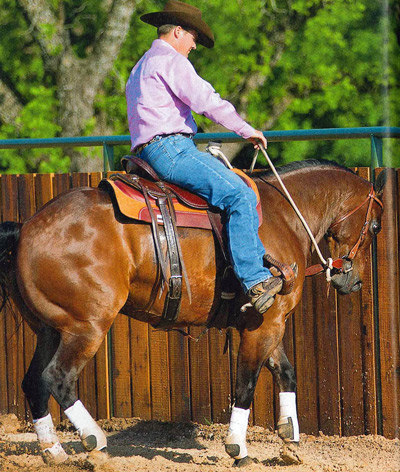 Q: My 16-year-old Quarter Horse mare refuses to sidepass under saddle. Whenever I push on her with my heel, she thinks that I want her to go faster. What can I do to help her understand what I want?
Q: My 16-year-old Quarter Horse mare refuses to sidepass under saddle. Whenever I push on her with my heel, she thinks that I want her to go faster. What can I do to help her understand what I want?
VIDEO: Watch how Clinton Anderson teaches the sidepass through groundwork >>
To keep your horse’s forward tendencies in check, and eliminate her confusion, teach her to sidepass on the fence, first yielding her hindquarters and then redirecting her energy sideways. The fence will stop your horse from walking forward, and yielding her hindquarters will set her feet in motion so you don’t have to create lateral movement from a standstill; you’ll just redirect her energy sideways.
Steps to Side passing on the Fence
- Walk your horse along the fence with both hands on the reins. Keep your reins short enough that your hands are in front of the saddle horn.
- Tip your horse’s nose slightly toward the fence, and put your outside leg back by her flank to yield her hindquarters.If you’re going counter-clockwise around the arena, you’ll tip your horse’s nose toward the fence with your right rein, and at the same time press with your right leg back near her flank to ask her to disengage her hindquarters.
- As soon as your horse yields her hindquarters 90 degrees, immediately move your leg up to her ribcage and apply pressure.
The key is to make it a smooth transition so she doesn’t stop moving her feet in between the hindquarter yield and the sidepass; it should all flow together.
- At the same time that you press with your leg in the middle of your horse’s ribcage, sit on your outside seatbone and point with your inside rein in the direction you want your horse to go. This will create an “open door” for her to move through.
To sidepass to the left, gently press your horse’s ribcage with your right leg, and open the door with your left rein and leg to give her direction. In the beginning, it will help to tip your horse’s nose slightly to the outside (opposite of the direction she’s going) to help her hindquarters stay in a straight line. - When your horse takes one step sideways, immediately release all pressure from your leg and reins and let her stop to rest. Make sure that when she stops, she’s facing the fence straight—her hindquarters and shoulders should be in a straight line.
- At the same time that you press with your leg in the middle of your horse’s ribcage, sit on your outside seatbone and point with your inside rein in the direction you want your horse to go. This will create an “open door” for her to move through.
Don’t be surprised if the sidepass isn’t pretty the first time you ask for it. The first time you teach a horse something is what I call the concept lesson—your goal is to get her to understand what you’re asking her to do. Once she understands the concept, you can start working toward perfection.
- Let your horse rest for 10 to 15 seconds, and then walk her off in the same direction. Walk 20 to 30 feet and then repeat the exercise.
It’s important to allow your horse to rest after each sidepass so she knows she gets a reward for trying and moving off of your leg. - As your horse gets better, you can start asking her to take two steps, then three, et cetera, until she can sidepass down the fence 10 to 15 feet.
- Let your horse rest for 10 to 15 seconds, and then walk her off in the same direction. Walk 20 to 30 feet and then repeat the exercise.
The secret to sidepassing is finding a starting point and then building off of it. One correct step is plenty for the first couple of lessons. After six or seven lessons, your horse will be able to easily sidepass 10 steps.
Tip for Success
Teach your horse to sidepass from the ground first so she will already understand the concept of the lesson when you attempt it in the saddle, ensuring you’ll run into less resistance.
When your horse can sidepass on the fence well, you can use the same concept to teach her how to sidepass away from the fence. But don’t move off the fence too quickly. You want to make sure your horse understands that when you apply pressure to her ribcage with one leg, you want her to move laterally, not forward.
Liked this article? Here’s more from Clinton Anderson:
Earn Your Horse’s Respect
No More Trailer Troubles
Video: Backing for Respect
Clinician Clinton Anderson owns and operates Downunder Horsemanship in Stephenville, Texas, where his method of horsemanship has helped to transform the relationship between thousands of horses and riders. He also hosts two training programs (Downunder Horsemanship) that air weekly on Fox Sports Net and RFD-TV. For more information and a schedule of events, visit www.downunderhorsemanship.com
This article originally appeared in the May 2011 issue of Horse Illustrated. Click here to subscribe!






This article makes it sound so easy. I will have to reread it a few times, and then go out and practice.
a lot of great info!
love all the tips. I had to do the same using the fence.
Great advice. Fences can be so handy!